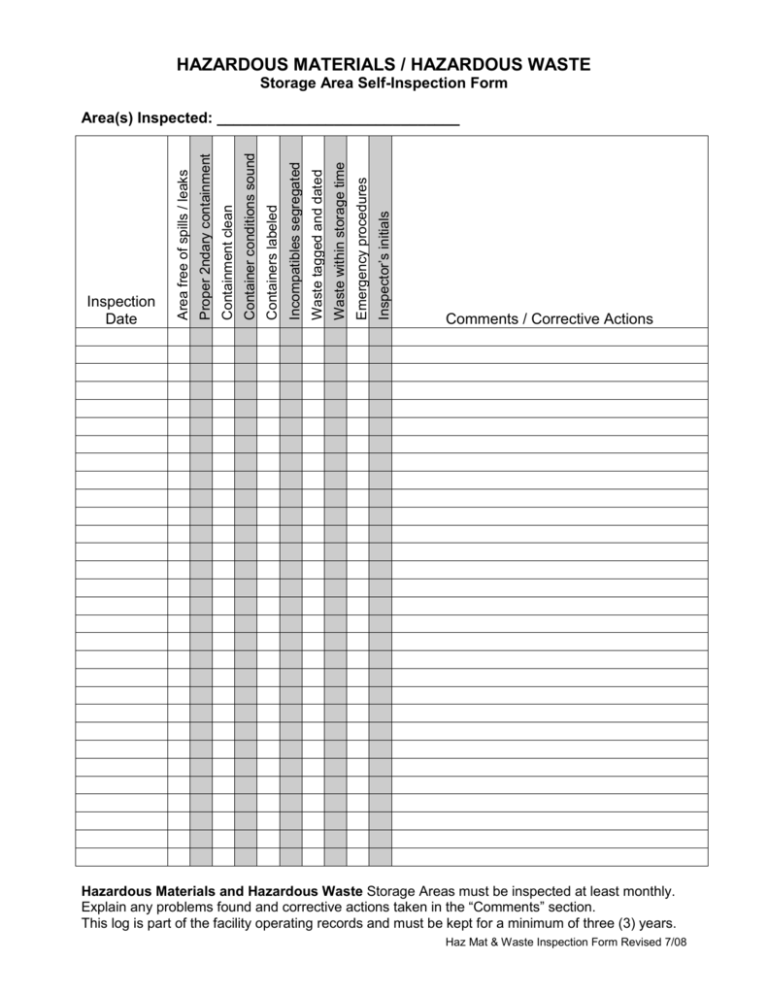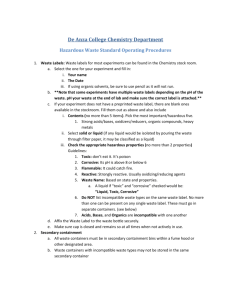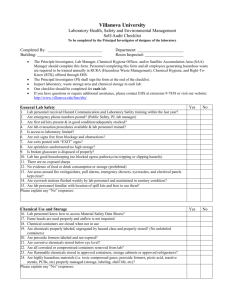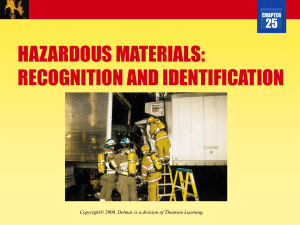Inspection Forms
advertisement

HAZARDOUS MATERIALS / HAZARDOUS WASTE Storage Area Self-Inspection Form Emergency procedures posted Inspector’s initials Waste within storage time Waste tagged and dated Incompatibles segregated Containers labeled Container conditions sound Proper 2ndary containment ccontainment Containment clean Inspection Date Area free of spills / leaks Area(s) Inspected: _____________________________ Comments / Corrective Actions Hazardous Materials and Hazardous Waste Storage Areas must be inspected at least monthly. Explain any problems found and corrective actions taken in the “Comments” section. This log is part of the facility operating records and must be kept for a minimum of three (3) years. Haz Mat & Waste Inspection Form Revised 7/08 How to Use the Storage Area Self-Inspection Form This form may be used for self-inspections of hazardous material storage areas and/or hazardous waste accumulation areas. Area Inspected: The area or areas being inspected should be indicated on the form. Each unit may decide how many forms are needed to best cover their storage areas. Inspection Date: Enter the month, day and year of the self-inspection. Area free of spills/leaks: Look on and around hazardous material containers and hazardous waste containers for signs of spilled or leaked materials. There should be no visible signs of contamination on tops or sides of waste containers, in the containment, or elsewhere in the general storage area. Wipe down or clean containers, containment and the storage area as necessary. Proper secondary containment: Is the secondary containment of adequate size? The volume of the secondary containment needs to be: o 110% the volume of a single container if only one is present or, o if multiple containers use a single secondary containment, the containment volume should be the larger of 150% of the largest container volume, or 10% of the total volume of all the containers. Is the secondary containment compatible with the chemicals to be stored? Make sure it won’t be degraded or corroded by a spill. Are all materials stored in the same secondary containment compatible? Make sure they won't chemically react with each other. The adequacy of secondary containment is dependent on many specifics of the storage location. If you would like assistance, contact the Environmental Programs Manager at 459- 3541. Container conditions sound: All containers of hazardous materials and hazardous wastes should be closed with a tightly fitting lid. A properly sealed container in sound condition will not leak when laid on its side or overturned. Incompatibles segregated: Are materials that could adversely interact with each other or the other containers separated by secondary containment and/or distance? For instance, are acids kept away from bases and flammables/combustibles separated from oxidizers? The product MSDS is a good source for identifying incompatible materials. For materials transferred to a new container, such as a spray bottle, is the material compatible with the new container? Waste tagged and dated: As soon as even one drop of hazardous waste is first added to a container, the EH&S hazardous waste label must be completed and attached. Hazardous waste labels are printed on line via the EH&S Online Tag program (OTP). For instructions, refer to http://ehs.ucsc.edu/Lab_Research_Safety/ehs.asp? page=Pubs/CHP/otpintro Waste within storage time: For areas subject to satellite accumulation requirements (almost all campus waste storage areas), containers should be removed within 3 months. To conform to regulatory requirements, all containers must be designated for pickup through the Online Tag program (OTP) within 6 months of the accumulation start date. Emergency procedures: For each area where hazardous materials or wastes are stored, verify that simplified response guides for emergencies are posted. Refer to http://ehs.ucsc.edu/Environmental_Programs/ehs.as p?page=Haz_Mat_Storage. Inspector’s initials Comments/Corrective actions: Explain any problems found and corrective actions taken. Follow-up promptly on deficiencies noted. When corrections are completed, initial, date and explain corrective actions taken. Containers labeled: All containers, whether the contents are hazardous or non-hazardous, including individual use containers, squeeze bottles and spray bottles, should have a legible label, which at a minimum indicates the name of the product and the primary hazard of the contents. Generally recognized products do not need the hazard indicated. Haz Mat & Waste Inspection Form Revised 11/15








